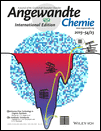Star/Linear Polymer Topology Transformation Facilitated by Mechanical Linking of Polymer Chains†
This research was financially supported by the ACT-C program of JST, a Grant-in Aid for Scientific Research from the Ministry of Education, Culture, Sports, Science and Technology, Japan (No. 26102512, 25410125, 26886006).
Graphical Abstract
From star to linear: A rotaxane-linked arm-containing star polymer, formed by the attractive interaction of ammonium and crown ether groups, was transformed to a linear polymer by the removal of the attractive interaction by the N-acetylation of the ammonium moiety. The polymer component linked to the wheel component of the rotaxane linkage moves to the urethane terminal, thereby changing its shape.
Abstract
Topology transformation of a star polymer to a linear polymer is demonstrated for the first time. A three-armed star polymer possessing a mechanical linking of two polymer chains was synthesized by the living ring-opening polymerization of δ-valerolactone initiated by a pseudo[2]rotaxane having three hydroxy groups as the initiator sites on the wheel component and at both axle termini. The polymerization was followed by the propagation end-capping reaction with a bulky isocyanate not only to prevent the wheel component deslippage but also to introduce the urethane moiety at the axle terminal. The resulting rotaxane-linked star polymer with a fixed rotaxane linkage based on the ammonium/crown ether interaction was subjected to N-acetylation of the ammonium moiety, which liberated the components from the interaction to move the wheel component to the urethane terminal as the interaction site, eventually affording the linear polymer. The physical property change caused by the present topology transformation was confirmed by the hydrodynamic volume and viscosity.





